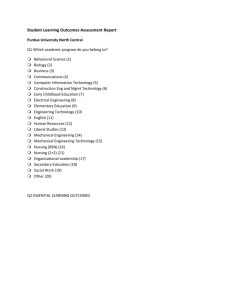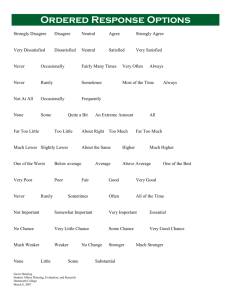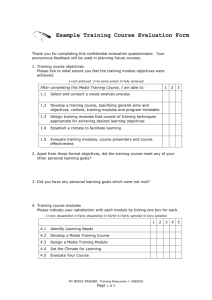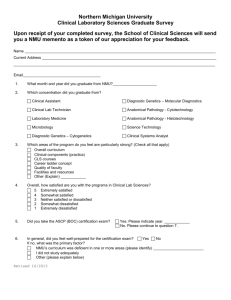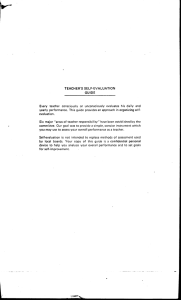Handout 6
advertisement
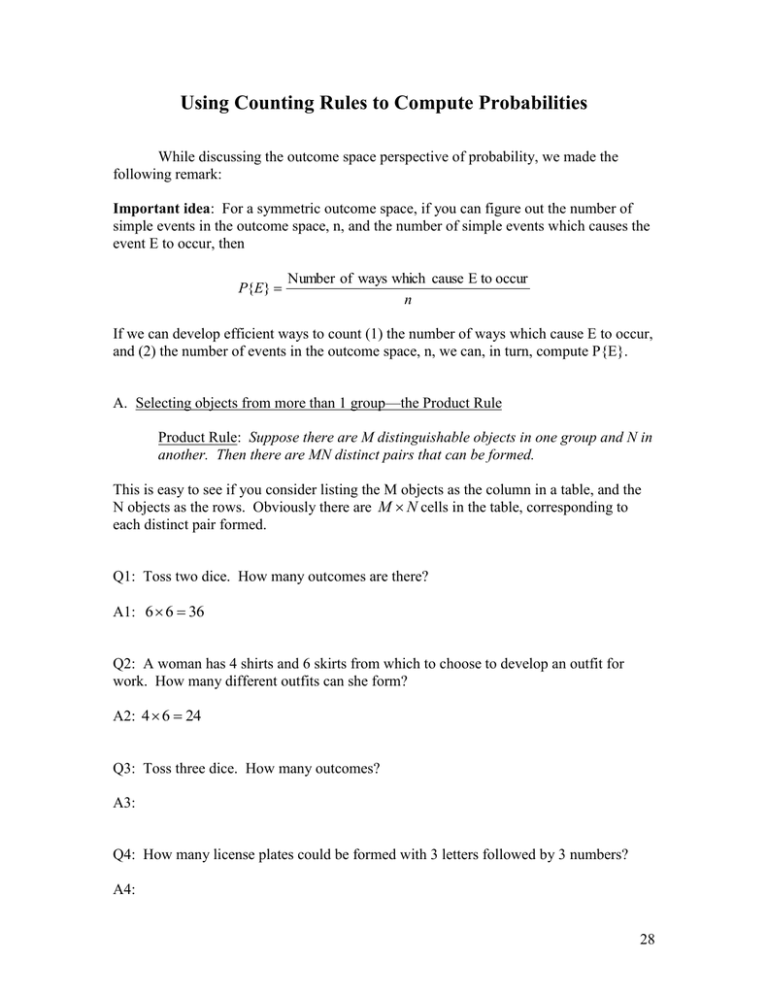
Using Counting Rules to Compute Probabilities
While discussing the outcome space perspective of probability, we made the
following remark:
Important idea: For a symmetric outcome space, if you can figure out the number of
simple events in the outcome space, n, and the number of simple events which causes the
event E to occur, then
P{E}
Number of ways which cause E to occur
n
If we can develop efficient ways to count (1) the number of ways which cause E to occur,
and (2) the number of events in the outcome space, n, we can, in turn, compute P{E}.
A. Selecting objects from more than 1 group—the Product Rule
Product Rule: Suppose there are M distinguishable objects in one group and N in
another. Then there are MN distinct pairs that can be formed.
This is easy to see if you consider listing the M objects as the column in a table, and the
N objects as the rows. Obviously there are M N cells in the table, corresponding to
each distinct pair formed.
Q1: Toss two dice. How many outcomes are there?
A1: 6 6 36
Q2: A woman has 4 shirts and 6 skirts from which to choose to develop an outfit for
work. How many different outfits can she form?
A2: 4 6 24
Q3: Toss three dice. How many outcomes?
A3:
Q4: How many license plates could be formed with 3 letters followed by 3 numbers?
A4:
28
B. Selecting objects from one group
Permutations: An ordered arrangement (that is, 1,2 is different from 2,1) of r
distinguishable objects is called a permutation. The number of permutations of r
objects taken from n distinguishable objects is given by
Prn
n!
(n r )!
Q5: How many ways can 10 people in a club choose a president, a vice president, and a
secretary?
A5: Represent a selection as an ordered triple (president, vice president, secretary).
(Why does it have to be ordered?) Then n = 10, r = 3, and
P310
10!
10!
10 9 8 720
(10 3)! 7!
Combinations: If order does not matter, then we are concerned with combinations.
The number of combinations of size r which can be selected from n distinguishable
objects is
n
n!
Crn
r (n r )! r!
Q6: How many committees of size 3 can be formed from 10 people?
A6: Since order does not matter (why?), we use n = 10, r = 3, and
10
10!
10! 10 9 8
120
3 (10 3)!3! 7!3! 3 2 1
Notice that if you assigned each person a letter (A, B, C, D, E, F, G, H, I, J), then the six
selections (assuming that order matters) (A, B, C), (A, C, B), (B, A, C), (B, C, A), (C, A,
B), and (C, B, A) all yield the same committee. In fact, given any three individuals, there
are 6 ways they could be selected. Thus if you take the number of ordered triples, 720,
and divide 6, you get our result of 120.
29
Q7: Assume you are to construct a committee of 4 people, two of which must be men
and two of which must be women. If you have 6 men to choose from and 4 women to
choose from, how many different committees can be formed?
A7: First consider the number of pairs of men you can select. Here order does not
matter, hence
6 6!
15
2 2!4!
In a similar manner, the number of pairs or women that can be formed can be computed
by
4 4!
6
2 2!2!
There are 15 pairs of men and 6 pairs of women to use to form the committee. Using the
product rule, the number of committees possible is given by 15 6 90 . This result is
summarized below as the hypergeometric rule.
Hypergeometric Rule: Assume that we divide a group of N objects into two
subgroups of size n and (N – n). The number of ways to choose r objects from the
subgroup of size n and s objects from the subgroup of size (N – n) is
n N n
r s
C. Using counting rules to compute probabilities
Q8: In a class of 20 students, 5 are dissatisfied with the text used. If a sample of 4
students is taken, what is the probability that (a) exactly 1 is dissatisfied? (b) 0? (c) 1 or
fewer?
A8: First consider the outcome space. We will select 4 students from 20. How many
ways can this happen?
20
20!
20 19 18 17
4845
4 3 2
4 4!16!
(Imagine having to write these out!)
30
Divide the 20 students into two groups, 15 who are satisfied with the text, and 5 who are
not. To compute P{exactly one student is dissatisfied}, how many satisfied students must
we select?
How many unsatisfied students?
The number of ways to select 3 satisfied students and 1 unsatisfied student is
15 5 15! 5! 15 14 13 5
2275
3 2
3 1 3!12! 1!4!
=>
P{exactly one student is dissatisfied} = 2275/4845 ≈ 0.47
========================
(b) To get exactly 0 dissatisfied students, we must select 4 satisfied students. Thus
15 5 15! 5! 15 14 13 12
1365
43 2
4 0 4!11! 0!5!
=>
P{exactly 0 students is dissatisfied} = 1365/4845 ≈ 0.28
========================
(c) P{one or fewer dissatisfied students}
= P{exactly 0 students dissatisfied} + P{exactly 1 student is dissatisfied}
= 0.28 + 0.47
= 0.75
31
Homework for Counting Rules
Solve this problem in the following two ways: (1) write out the outcome space
and count to determine the answer; (2) use our counting rules to get the same result.
It is suspected that some vintage wines are bottled after the addition of cheap
imported wine. An expert claims to be able to detect such “doctoring.” He is presented
with six bottles and told that three bottles contain the genuine wine and three bottles are
doctored. The expert selects three bottles.
(a) If the expert has no power to discriminate, what is the probability of his being
able to identify correctly the three genuine wines?
(b) Based on your answer to part (a), should we conclude that the expert can indeed
discriminate if he correctly identifies the three bottles?
Additional problem: 5 cards are selected randomly from a standard deck of 52 playing
cards.
(a) How many ways can you select 5 cards from 52? (How large is our outcome
space?)
(b) How many ways can you select 5 cards and have all spades? Hearts? Diamonds?
Clubs?
(c) What is the probability that you get all spades? Hearts? Diamonds? Clubs?
(d) What is the probability that you get 5 cards of the same suit? (Hint: Based on the
answer to (b), how many outcomes does this correspond to?)
32
